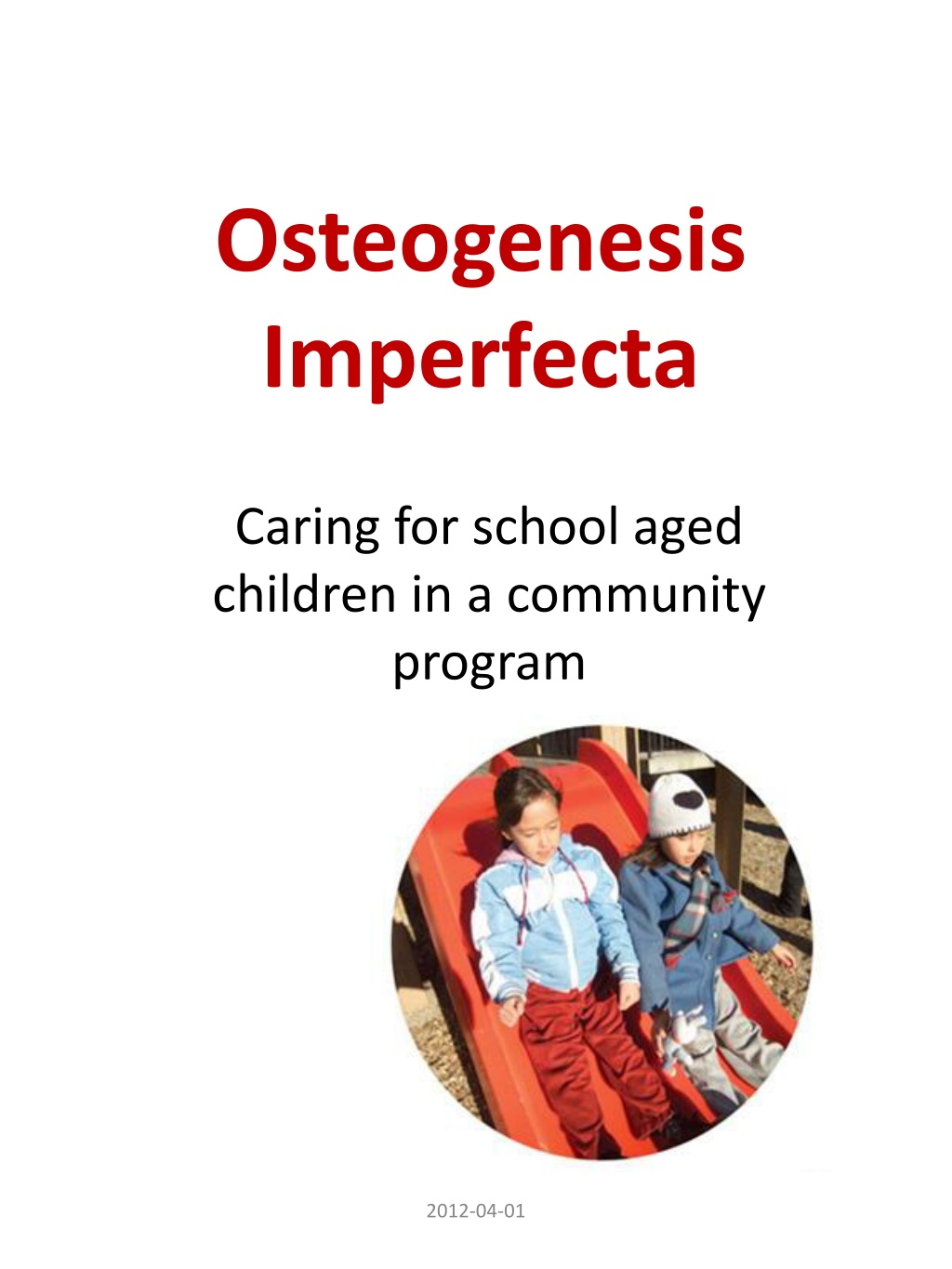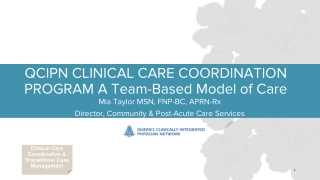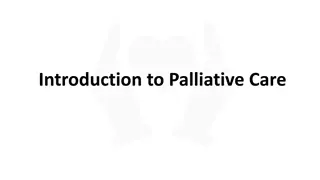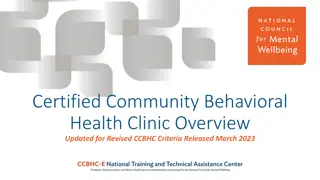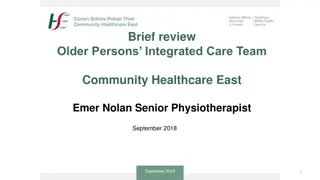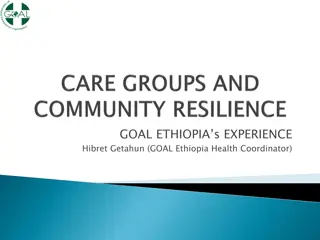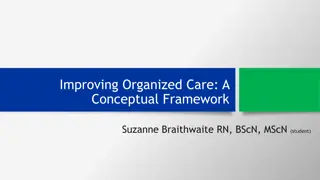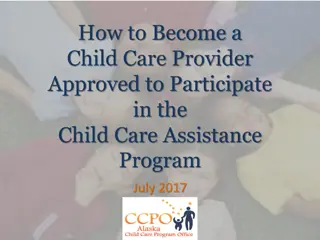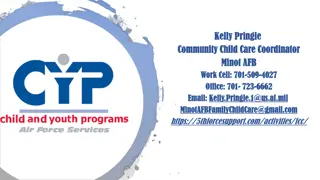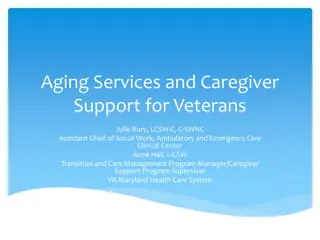Understanding Osteogenesis Imperfecta: Care in a Community Program
Osteogenesis Imperfecta (OI), also known as brittle bone disease, is a genetic disorder characterized by fragile bones that break easily, affecting bone quality and mass. Children with OI may experience short stature, weak tissues, muscle weakness, loose joints, and other health issues. There are eight types of OI, with varying severity and medical complications. Treatment aims to minimize fractures and improve independent function. Safety precautions in a school setting are crucial to accommodate children with OI effectively.
Download Presentation

Please find below an Image/Link to download the presentation.
The content on the website is provided AS IS for your information and personal use only. It may not be sold, licensed, or shared on other websites without obtaining consent from the author. Download presentation by click this link. If you encounter any issues during the download, it is possible that the publisher has removed the file from their server.
E N D
Presentation Transcript
Osteogenesis Imperfecta Caring for school aged children in a community program 2012-04-01
Osteogenesis Imperfecta Brittle bone disease genetic disorder Characterized by fragile bones that break easily. Affects both bone quality and bone mass. Other health issues frequently seen in children with OI: Short stature Weak tissues, fragile skin, muscle weakness, and loose joints Bleeding, easy bruising, frequent nosebleeds Hearing loss Breathing problems Curvature of the spine
Types of OI 8 types OI types range from a mild form with no deformity, normal stature and few fractures to a form that is lethal during the perinatal period (prior to and after birth). Medical problems a person will depend on the type of OI OI varies greatly from person to person, even among people with the same type of OI, even within the same family
Type I mildest and most common form 50% of the total OI population mild bone fragility relatively few fractures minimal limb deformities child might not fracture until he or she is learning to walk. Shoulders and elbow dislocations may occur more frequently than in healthy children Some children have few obvious signs of OI or fractures while others experience multiple fractures of the long bones, compression fractures of the vertebrae, and chronic pain. Appear healthy yet need to accommodate for bone fragility
Treatment There is no cure for OI. Treatment goals Minimize fractures Maximize independent function and general health Treatments Physical therapy and safe exercise Casts, splints or wraps for broken bones; Braces to support legs, ankles, knees and wrists as needed Orthopedic surgery Medications to strengthen bones Mobility aids Some children may need physical or occupational therapy to maximize their skills and independence
SAFETY PRECAUTIONS School setting Physical barriers should be addressed if they interfere with a child s participation Stairs Restrooms with narrow or heavy doors High sinks, stalls too narrow for a wheelchair Play structures with stairs Inaccessible hands-on work areas Possible strategies providing an aide to assist a child in the restroom portable ramps and wheelchair lifts lowering lockers, shelves, soap dispensers providing a low desk or work surface
SAFETY PRECAUTIONS Classroom/hallway Crowded hallways and classrooms may pose problems Suggested strategies Allow child to leave class several minutes early In multi-level school buildings, allow child to use elevator Allow the child to select a seat that is easy to get to Provide an extra set of books
SAFETY PRECAUTIONS Gym Participation is very important for children with OI. Make every effort to involve the child in the same activities as everyone else with appropriate modifications If you are not certain if a child with OI should participate discuss it with the parent/guardian. May be restricted from playing contact sports Avoid activities that jar or twist the spine Wearing a helmet and knee/elbow pads for sports like bike riding and roller blading, is recommended. Good fitting shoes help to support the ankles, and prevent tripping/slipping
SAFETY PRECAUTIONS Recess Special playground equipment for children with disabilities Children with OI may also be able to use traditional equipment, such as slides or jungle gyms, with or without adult assistance. remind all children that safe and considerate play is important for preventing injury
SAFETY PRECAUTIONS Fire evacuation An evacuation plan should be established and practiced during routine drills Suggested strategies assign a particular staff person to accompany a child with OI In a multi-level school building, a specific plan for evacuation must be made. It is possible for two adults to carry a child in a wheelchair down steps safely.
SAFETY PRECAUTIONS Transportation May need someone to assist them on and off the bus Because most school buses do not have seat belts, may be at increased risk during an accident or if the bus stops short. If the child s need for a seat belt is included in the written plan, this should be discussed with the school. Back of the bus often provides a bouncier ride than the front of the bus. This may be dangerous for a child with OI
EMERGENCY RESPONSE PLAN The following situations may indicate a fracture Child complains of pain in a bone that gets worse with movement Swelling or bruising over a bone Child has deformed limb Child is not using the limb Child winces or looks like that may be uncomfortable during routine play or exercises If any of the above situations occur: 1. Contact the child s parent/guardian. 2. If you are unable to contact the parent/guardian or alternate contact, call 911/EMS. 3. Inform the paramedics that the child has OI.
EMERGENCY RESPONSE PLAN Do not move the affected area unless it is absolutely necessary Listen to the child s advice. Make the child comfortable. Provide a blanket, a basin, or whatever else the child might need. Do not provide food or drink Staff should only apply a splint if the parent has instructed them to do so or if the child must be moved before a parent or other caregiver arrives.
Health Care Plans Type of OI Safety precautions Emergency Response Plan Health care plans are located in the office Document relevant events and actions in health care plan
Health Care Plans Type of OI Safety precautions Emergency Response Plan Health care plans are located in the office Document relevant events and actions in health care plan
Child specific information Type of OI Safety precautions Emergency Response Plan Health Care Plans are located in child file and binder
